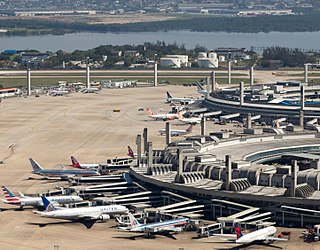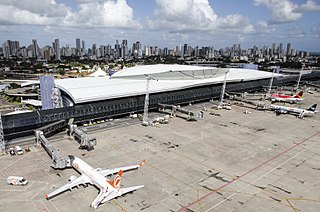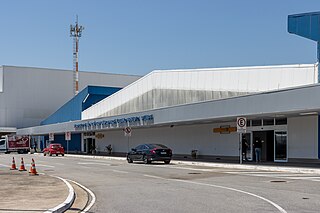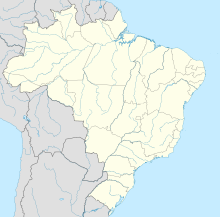
Viracopos/Campinas International Airport is an international airport serving the municipality of Campinas, in the state of São Paulo.

São Paulo/Guarulhos–Governor André Franco Montoro International Airport, commonly known as São Paulo/Guarulhos International Airport, is the primary international airport serving São Paulo. It is popularly known locally as either Cumbica Airport, after the district where it is located and the Brazilian Air Force base that exists at the airport complex, or Guarulhos Airport, after the municipality of Guarulhos, in the state of São Paulo, where it is located. Since November 28, 2001, the airport has been named after André Franco Montoro (1916–1999), former Governor of São Paulo state. The airport was rebranded as GRU Airport in 2012.

Empresa Brasileira de Infraestrutura Aeroportuária is a Brazilian government corporation founded in 1973, authorized by Law 5,862, that is responsible for operating the main Brazilian commercial airports. In 2011 Infraero's airports carried 179,482,228 passengers, 1,464,484 tons of cargo, and operated 2,893,631 take-offs and landings. Presently it manages 45 airports.

São Paulo/Congonhas–Deputado Freitas Nobre AirportPortuguese pronunciation:[kõˈɡõɲɐs] is one of the four commercial airports serving São Paulo, Brazil. The airport is named after the neighborhood where it is located, called Vila Congonhas, property of the descendants of Lucas Antônio Monteiro de Barros (1767–1851), Viscount of Congonhas do Campo, first president of the province of São Paulo after the independence of Brazil in 1822, during the Empire. In turn, the Viscount's domain was named after the plural of a shrub known in Brazil as congonha-do-campo. Since June 19, 2017, it is officially named after Deputy José Freitas Nobre. The name Congonhas, however, remains mostly used. It is owned by the City of São Paulo.

Rio de Janeiro/Galeão–Antonio Carlos Jobim International Airport, popularly known by its original name Galeão International Airport, is the main international airport serving Rio de Janeiro, Brazil.

Curitiba-President Afonso Pena International Airport is the main airport serving Curitiba, located in the municipality of São José dos Pinhais, in the state of Paraná. Since July 15, 1985 it is named after Afonso Augusto Moreira Pena (1847–1909), the 6th President of Brazil.

Santos Dumont Airport is the second major airport serving Rio de Janeiro, Brazil. It is named after the Brazilian aviation pioneer Alberto Santos Dumont (1873–1932). It is operated by Infraero.

Manaus–Eduardo Gomes International Airport is an international airport serving Manaus, Brazil. On December 11, 1973, while still under construction, the name of the facility was changed from Supersonic Airport of Manaus to Eduardo Gomes International Airport, celebrating the Brazilian politician and military figure Air Marshal Eduardo Gomes (1896–1981).

Pampulha–Carlos Drummond de Andrade Airport is an airport serving Belo Horizonte, Brazil, located in the neighborhood of Pampulha. Since December 16, 2004, the airport is also named after the Minas Gerais-born poet Carlos Drummond de Andrade (1902–1987).

Aeroporto Internacional do Recife/Guararapes–Gilberto Freyre is the airport serving Recife, Brazil. Since December 27, 2001 it is named after the Recife-born Anthropologist and Sociologist Gilberto de Mello Freyre (1900–1987). Some of its facilities are shared with the Recife Air Force Base of the Brazilian Air Force.

Fortaleza–Pinto Martins International Airport is the international airport serving Fortaleza, Brazil. It is named after Euclides Pinto Martins (1892–1924), a Ceará-born aviator who in 1922 was one of the pioneers of the air link between New York City and Rio de Janeiro.

São José dos Campos-Professor Urbano Ernesto Stumpf International Airport, is the airport serving São José dos Campos, Brazil. Since November 9, 2004, it is named after Urbano Ernesto Stumpf (1916–1998), colonel-aviator, Aerospace Engineer, professor at several universities and inventor of the motor that runs on ethanol fuel.

Palmas–Brigadeiro Lysias Rodrigues International Airport is the airport serving Palmas, Brazil. The airport is named after Brigadier Lysias Augusto Rodrigues (1896–1957), one of the founding figures of the Brazilian Air Force and crucial to the integration of Tocantins to Brazil via the passenger air services of the Brazilian Air Force.

Rio Grande do Norte/São Gonçalo do Amarante–Governador Aluízio Alves International Airport is an international airport in São Gonçalo do Amarante, Brazil serving Natal and its metropolitan area.

Jacarepaguá–Roberto Marinho Airport is an airport in the neighborhood of Barra da Tijuca, Rio de Janeiro, Brazil dedicated to general aviation. Following extensive renovation in 2008 the airport was renamed after Roberto Pisani Marinho (1904–2003), a journalist and former president of Globo Network. It is a major helibase for offshore support.

Natal Air Force Base – ALA10 is a base of the Brazilian Air Force, located in Parnamirim, near Natal, Brazil.

Lauro Kurtz Airport is the airport serving Passo Fundo, Brazil. Since June 5, 1959 it is named after Lauro Ignacio Kurtz (1917-1949), sometimes also written Kortz, a pilot of the airline SAVAG, killed on an air-crash in 1949.

Brasília–President Juscelino Kubitschek International Airport is the international airport serving Brasília. Since April 20, 1999, the airport is named after Juscelino Kubitschek (1902–1976), the 21st President of Brazil.

Montes Claros–Mário Ribeiro Airport is the airport serving the city of Montes Claros, Brazil. Since April 2, 2003, the airport is named after Mário Ribeiro (1924–1999), a local politician.
Brigadeiro Protásio de Oliveira Airport, formerly called Júlio César Airport, was an airport serving Belém, Brazil. Since 14 April 2010, it was named after Protásio Lopes de Oliveira (1923–2003) former president of Infraero and commander of the 1st Regional Air Force.




















